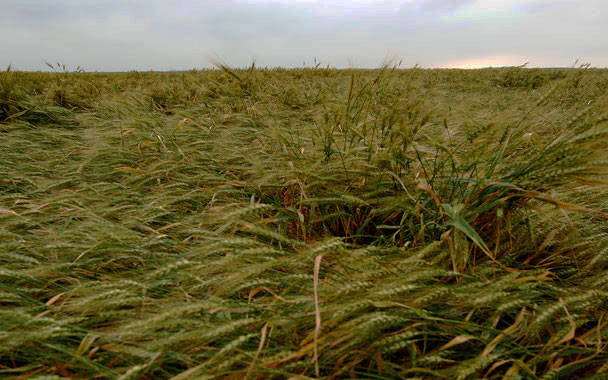We are at the halfway point. Our four production farmers on the Great Plains went into the ground with “King Corn” in late April. They will harvest in mid-October. They struggled against cold, wet spring weather to get their seed in the ground. They watched the spot market rise as high as $6.70 a bushel against early summer flooding that left a fifth of Iowa’s corn seed rotting under water. They followed corn into the ground with spring wheat, oats, soybeans, and sunflowers. They sprayed and hacked away against an onslaught of fungus and weeds that fought the young crops for sunlight and soil moisture. Through late June and early July it looked like a bumper crop. Maybe a record crop. “It seems like we never have high prices and high yields in the same season,” Dale Hargens joked in late June. “We never have both together.” But this year things looked different. This year has the potential to be a “bin buster.” Hargens offered a guess. “We need a good soaking rain in July, and one more in August to get us to a great crop.” He was dreaming of 175 bushels an acre, $6 a bushel. Unlikely. Everything would have to go just right.
On July 1, Jim Lutter looked into the sky and announced with brash cynicism, as if he was trying to protect himself against the obvious, “It’s going to stop now. We may not see another rain.” It sprinkled the next day, and then it stopped.
The first two weeks of July were hot, into the 90s, and humid. On July 15, Hargens reported with grim understatement, “The corn really needs a drink.” Lutter worried. “If the rains don’t come in the next week, the corn may not be able to recover. There’s a big difference between enough moisture not to burn up, and enough moisture to get a decent yield.” And then, in the middle of the night on July 19, the skies opened and it rained.
Lutter measured an inch and three quarters on his farm, and just forty miles north, Hargens’ cornfield soaked up four and a half inches. One man’s dark horizon is another man’s downpour. A hundred miles east, Charlie Johnson measured 1.8 inches. The rain had barely hit the ground when Johnson announced, “Great. Now we need it to stop.” Nothing is ever good enough for these guys.
Over the last 10,000 years, human civilization has thrived in regions where climate has been the most steady and benign. Crops need wet, deep spring snowstorms and slow, steady, soaker rains. The very word “flash” makes farmers wince. They hate surprises. But farming on the Great Plains is full of surprises. Along with the rain came wind. Just ten miles north of Lutter’s farm, the National Weather Service recorded 60-mile-an-hour winds in the dark morning of July 17. The wheat and corn lay over in the fields. Broken? It will take a week to tell how bad the damage is. On July 19, a funnel cloud touched down near the small town of Polo, seven miles west of Hargens’ cornfield, a near miss. The next night a hailstorm roared its way across southern Hand County. It caught the edge of the Hutterite Colony and Sunshine Bible Academy. It missed Lutter by a dozen miles. It hit Dale Hargens square. He lost a quarter, maybe a third, of his winter wheat crop. He had planted in the fall of ’07. The wheat had thrived through the spring snows, survived the hot, dry days of early July, and now, just ten days before harvest, it had been diced and sliced. Jim Lutter offered the judgement of Hargens’ neighbors. “It sucks. I really feel for him. To get this close and lose it. It just really sucks.”
Over the last decade, scientists have tried to get a handle on the real-world consequences of global warming. They cannot tell us that any one specific hurricane, or forest fire, or tornado is caused by global warming. But they can tell us that the weather will be more extreme, more unstable; that we are looking at a permanent disaster economy. After last week, I started thinking, if we want to understand the ecological and economic consequences of climate change, scientists should be studying those places on earth that are naturally extreme and unstable. They might start with the farms on the Great Plains. The northern Plains routinely dominate federal farm disaster payments. In fact, in last year’s farm bill negotiations, members of Congress from Great Plains states lobbied for and won a permanent disaster slush fund.
Local farmers hate the question, they hate to even think about it, but it has been around ever since John Wesley Powell first challenged the popularity of the Homestead Act over a century ago. It is a question hidden beneath layers of government “safety net” payments, crop insurance, and disaster relief. But after weeks like last week, it’s hard not to think about. If farming on the Plains is a permanent disaster, why are we growing crops there at all?




 Pinterest
Pinterest


